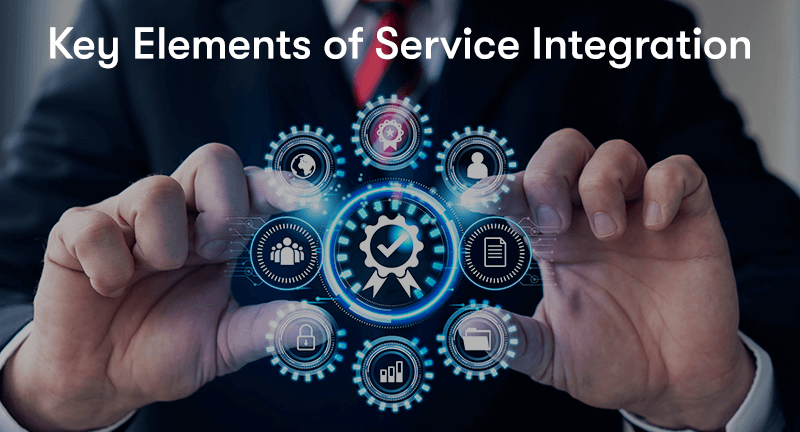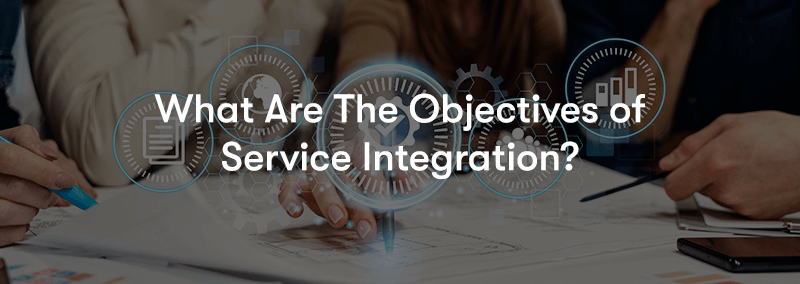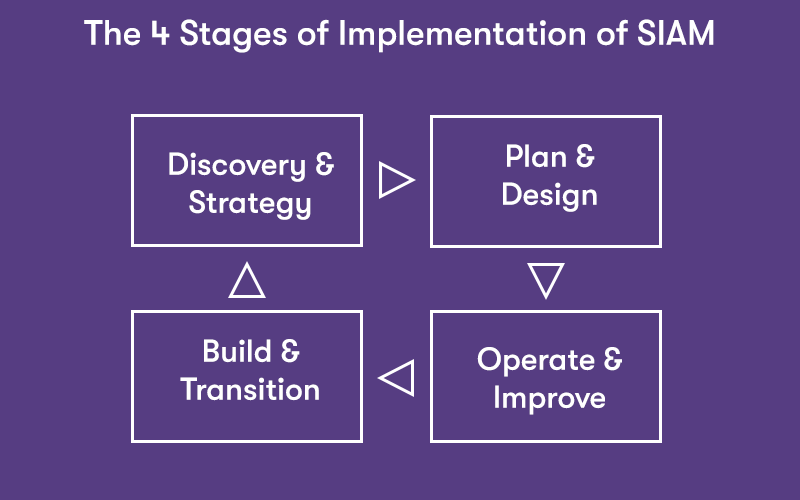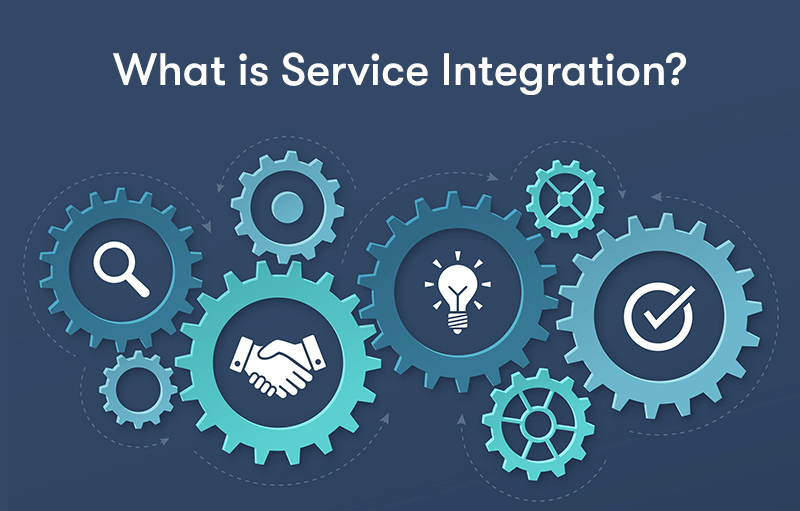What is Service Integration?
Service integration, also known as service integration and management (SIAM), is an approach used in the management of multiple service providers to ensure effective and efficient delivery of services to an organisation. In the modern business landscape, companies often rely on various external service providers, each responsible for delivering specific services or components. These providers could be IT outsourcing companies, cloud service providers, human resources firms, or any other specialised service vendors.
The challenge arises when multiple service providers need to work together in a coordinated manner to meet the organisation's overall objectives. Service integration helps address this challenge by establishing a framework that facilitates collaboration, coordination, and governance among these providers.
Key Elements of Service Integration

Key elements of service integration include:
End-to-End Service Management
The focus is on managing services across their entire lifecycle, from planning and design to delivery and ongoing support.
Service Agreements and SLAs
Clear service agreements and service level agreements (SLAs) are defined to ensure that each service provider knows their responsibilities and the expected performance standards.
Service Integration Role
A service integrator is often designated to act as the central point of coordination between the various service providers. This role ensures smooth communication and collaboration.
Governance and Performance Management
Metrics and KPIs are established to monitor the performance of the service providers and ensure that they meet the agreed-upon targets.
Service Reporting and Communication
Regular reporting and communication mechanisms are put in place to keep all stakeholders informed about service performance and progress.
Service Continual Improvement
An emphasis on continual improvement helps identify areas for enhancement and optimisation of service delivery.
What Are The Objectives of Service Integration?

The objective of service integration is to ensure the effective and efficient delivery of services to an organisation by coordinating and managing multiple service providers. The primary goals of service integration include:
Enhanced Service Delivery
The main objective is to improve the overall quality of services delivered to the organisation by different service providers. This involves ensuring that services are delivered in a consistent, timely, and reliable manner.
Streamlined Processes
Service integration aims to establish standardised processes and procedures across multiple service providers. This reduces duplication of efforts, minimises potential conflicts, and creates a more seamless service experience.
Improved Communication and Collaboration
The coordination provided by service integration facilitates better communication and collaboration among different service providers. This ensures that they work together harmoniously to meet the organisation's needs.
Effective Governance
Service integration establishes a governance framework that clarifies roles, responsibilities, and accountability for each service provider. This enables better oversight and control over service delivery.
Clear Service Level Agreements (SLAs)
Defining specific SLAs for each service provider helps set clear expectations regarding performance standards and ensures that the services meet the organisation's requirements.
Cost Optimisation
By managing service providers more efficiently, service integration can lead to cost optimisation and improved value for money in service delivery.
Flexibility and Scalability
Service integration allows organisations to adapt to changing needs and requirements more effectively. It provides the flexibility to add or remove service providers as the business landscape evolves.
Continuous Improvement
An essential objective of service integration is to promote continuous improvement in service delivery. By regularly evaluating performance and identifying areas for enhancement, the overall service quality can be enhanced.
Alignment with Business Objectives
Service integration ensures that all services are aligned with the organisation's strategic goals and priorities. It helps to avoid situations where services might deviate from the business objectives.
Risk Management
By actively managing service providers and having contingency plans in place, service integration helps mitigate risks associated with service delivery disruptions.
The 4 Stages of Implementation of SIAM

The implementation of Service Integration and Management typically involves four key stages. These stages provide a structured approach to introducing SIAM into an organisation and ensuring its successful adoption. The four stages of SIAM implementation are as follows:
Discovery and Strategy:
- In this initial stage, the organisation conducts a thorough assessment of its existing service provider landscape. This involves identifying all the current service providers, understanding the services they deliver, and evaluating their performance.
- The organisation also defines its strategic objectives and the desired outcomes from implementing SIAM. This includes understanding the business needs, identifying pain points, and setting clear goals for service improvement and integration.
- During this stage, key stakeholders are engaged, and their expectations are captured to ensure that SIAM aligns with their needs and requirements.
Plan and Design:
- Once the discovery and strategy phase is completed, the organisation develops a detailed plan for the implementation of SIAM. This plan outlines the roadmap, timelines, resource requirements, and the steps needed to achieve the defined objectives.
- The SIAM design phase involves creating the necessary processes, governance structures, and integration mechanisms to manage the multi-sourced service environment effectively. This includes defining the roles and responsibilities of the service integrator, service providers, and other stakeholders.
- Additionally, the organisation establishes service level agreements (SLAs) and performance metrics to measure and monitor the service providers' performance.
Build and Transition:
- In this stage, the organisation puts the SIAM framework into action. It involves setting up the required infrastructure, tools, and processes to support the service integration.
- The service integrator role may be established or strengthened, and any necessary training and upskilling of personnel is conducted.
- During the transition phase, the organization carefully manages the handover of services from individual providers to the integrated SIAM model. This may involve dealing with contractual and operational issues and ensuring a smooth transfer of responsibilities.
Operate and Improve:
- The final stage is the ongoing operation of the SIAM model. The organisation actively manages and governs the integrated services, ensuring that they align with the business objectives and SLAs.
- Regular reviews and evaluations are conducted to identify areas for improvement and optimisation. Continual service improvement practices are applied to enhance service quality, efficiency, and customer satisfaction.
- Additionally, the organisation maintains a focus on managing relationships with service providers and continuously monitors their performance and adherence to SLAs.
It's important to note that the implementation of SIAM is a continuous process that requires ongoing monitoring and adjustment to ensure it meets the organisation's evolving needs and changing service provider landscape.
SIAM Organisational Structures
In the context of Service Integration and Management, there are four main organisational structures that organisations can adopt to implement and manage SIAM effectively. These structures define how the SIAM function is organised and positioned within the organisation. The four main SIAM organisational structures are as follows:
Internal SIAM:
In an Internal SIAM structure, the organisation establishes an internal team or department responsible for service integration and management. This team acts as the central point of coordination and governance for all the service providers.
The internal SIAM team collaborates closely with various service providers and ensures that the services are integrated and delivered seamlessly to meet the organisation's needs.
This model provides the organization with a higher level of control and direct oversight of the SIAM function, as it is managed internally.
External SIAM:
In an External SIAM structure, the organization outsources the service integration and management function to a third-party SIAM provider.
The external SIAM provider takes on the responsibility of coordinating and managing the relationships between different service providers, ensuring service integration, and overseeing service delivery.
This model allows the organization to focus on its core business while leveraging the expertise of the external SIAM provider for managing the multi-sourced service environment.
Lead Supplier SIAM:
In a Lead Supplier SIAM structure, one of the service providers within the ecosystem takes on the role of the lead supplier and acts as the service integrator.
The lead supplier is responsible for coordinating and managing the other service providers, ensuring collaboration, and overseeing end-to-end service delivery.
This model is suitable when one of the service providers has the capabilities and experience to handle the SIAM function efficiently and collaboratively with other providers.
Hybrid SIAM:
In a Hybrid SIAM structure, a group of service providers forms a hybrid group and collaborates to deliver integrated services to the organisation.
Each hybrid member takes on responsibility for specific services, and together, they work as a unified team to provide end-to-end service delivery.
This model allows organisations to benefit from the combined expertise and resources of the hybrid members.
The choice of the SIAM organisational structure depends on various factors, including the organisation's size, complexity of the service landscape, strategic objectives, and existing relationships with service providers. Each structure has its advantages and challenges, and organisations need to carefully evaluate their specific requirements before deciding on the most suitable SIAM organisational approach.
The Benefits of Service Integration (SIAM)

Service integration and management offers several benefits to organisations that rely on multiple service providers. Some of the key advantages of implementing SIAM include:
Improved Service Quality
SIAM ensures a consistent and standardised approach to service delivery across different providers, leading to improved service quality and a better user experience for the organisation.
Efficient Service Delivery
By streamlining processes and reducing duplication of efforts, SIAM increases the efficiency of service delivery, resulting in faster response times and quicker issue resolution.
Enhanced Governance and Control
SIAM provides a governance framework that clarifies roles, responsibilities, and accountability for each service provider, enabling better oversight and control of service performance.
Cost Optimisation
Effective management of service providers through SIAM can lead to cost optimisation, as resources are utilised more efficiently, and redundant services are minimised.
Flexibility and Scalability
SIAM allows organisations to easily adapt to changing needs and scale their services up or down as required without significant disruptions.
Simplified Vendor Management
Instead of dealing with multiple service providers individually, SIAM centralises vendor management, reducing administrative overhead and complexity.
Effective Collaboration
SIAM fosters better communication and collaboration between different service providers, encouraging them to work together towards common goals.
Clear SLAs
Defining specific SLAs for each service provider helps set clear expectations and ensures that services meet the organisation's requirements.
Focus on Core Competencies
SIAM allows the organisation to focus on its core competencies while leaving the management of specialised services to the relevant service providers.
Risk Management
By actively managing service providers and having contingency plans in place, SIAM helps mitigate risks associated with service delivery disruptions.
Alignment with Business Objectives
SIAM ensures that all services align with the organisation's strategic goals and priorities, avoiding situations where services might deviate from business objectives.
Continuous Improvement
SIAM emphasises continuous improvement in service delivery through regular evaluation and identification of areas for enhancement.
Service Innovation
By leveraging the expertise of multiple service providers, SIAM can foster service innovation, leading to the adoption of new technologies and best practices.
Transparency and Reporting
SIAM provides transparent reporting on service performance, allowing the organisation to make data-driven decisions and assess the value delivered by each service provider.
Where Can You Learning More?
SIAM™ Foundation Course
Our SIAM™ Foundation training course will help you to:
- Understand the main concepts and processes of SIAM™ that are used in organisations.
- Establish a SIAM™ ecosystem in order to better organise the organisation's resources.
- Provide better support during a SIAM™ implementation by understanding the main considerations for the most important processes.

SIAM™ Professional Course
Our SIAM™ Professional training course will help you to:
- Establish a governance framework based on SIAM™ practices.
- Perform an organisation assessment to better determine and establish a plan and promote improvements.
- Determine the key elements to perform a SIAM™ implementation.

How does SIAM Integrate With Other Methodologies?
Service Integration and Management can complement and work in conjunction with other methodologies such as ITIL (Information Technology Infrastructure Library) and PRINCE2 (Projects IN Controlled Environments). Each of these methodologies has its specific focus, and SIAM can help integrate and manage the services and projects effectively within the organisation.
SIAM and ITIL:
- ITIL is a widely adopted framework for IT Service Management, focused on defining best practices for managing IT services. It provides guidelines for service strategy, design, transition, operation, and continual service improvement.
- SIAM can be seen as an extension of ITIL, as it addresses the challenges that arise when multiple service providers are involved. SIAM ensures coordination and collaboration among various service providers to deliver end-to-end IT services.
- While ITIL focuses on the processes and practices for individual service providers, SIAM extends this scope to include the integration and management of services across multiple providers.
SIAM and PRINCE2:
- PRINCE2 is a project management methodology that provides a structured approach to managing projects. It offers a set of principles, processes, and themes for effective project delivery.
- SIAM and PRINCE2 can work together when IT projects involve multiple service providers. PRINCE2 provides a framework for project management, while SIAM ensures that the services delivered within the project align with the organisation's overall service strategy and integrate seamlessly with other services.
- When implementing IT projects with various service providers involved, SIAM can act as the governance and coordination layer, ensuring that project outcomes align with the organisation's service objectives.
SIAM, ITIL, and PRINCE2:
- When an organisation adopts SIAM, ITIL, and PRINCE2 together, they can create a comprehensive approach to managing services, projects, and service providers.
- ITIL provides the best practices for individual service providers, ensuring that services are designed, delivered, and supported effectively.
- PRINCE2 ensures that projects are managed efficiently and deliver the desired outcomes within defined timeframes and budgets.
- SIAM acts as the glue that integrates these practices, ensuring that the services delivered by different providers align with business objectives, are coordinated effectively, and meet the organisation's needs.
In summary, SIAM, ITIL, and PRINCE2 can work synergistically to support an organisation's overall IT service and project management initiatives. ITIL provides the foundation for managing individual services, PRINCE2 offers project management principles, and SIAM facilitates the integration and coordination of services and projects across multiple providers to achieve seamless service delivery and project success.
Final notes on What is Service Integration?
In conclusion, Service Integration and Management is a strategic approach that manages multiple service providers, ensuring seamless and efficient service delivery. It offers a unified view of service management, integrating various processes, roles, and tools.
Key benefits include improved service quality, clearer accountabilities, and enhanced flexibility. Organisationally, SIAM encompasses service providers, a central service integrator, standardised processes, and a governance framework.
Implementation involves stages of establishing the vision, designing the framework, transitioning services, and continuous improvement. Embracing SIAM paves the way for organisations to achieve streamlined operations and optimal service integration in today's multifaceted IT landscapes.


